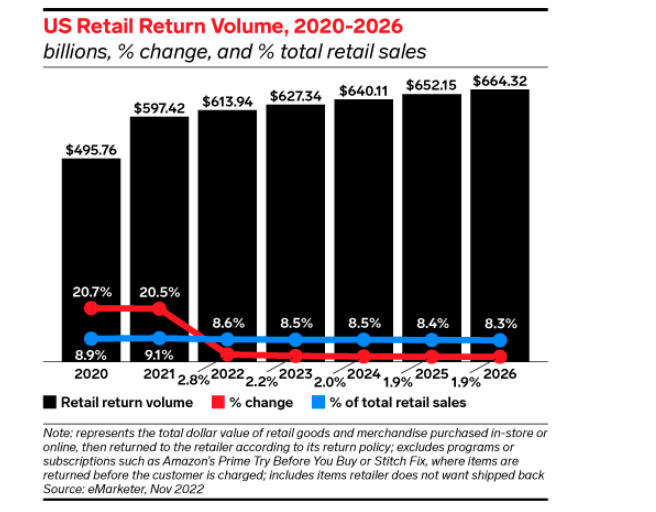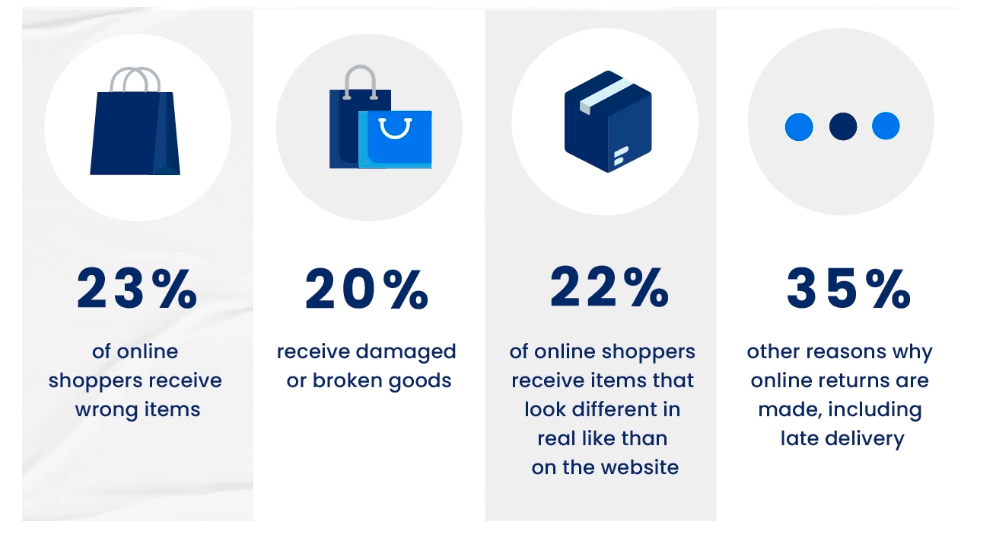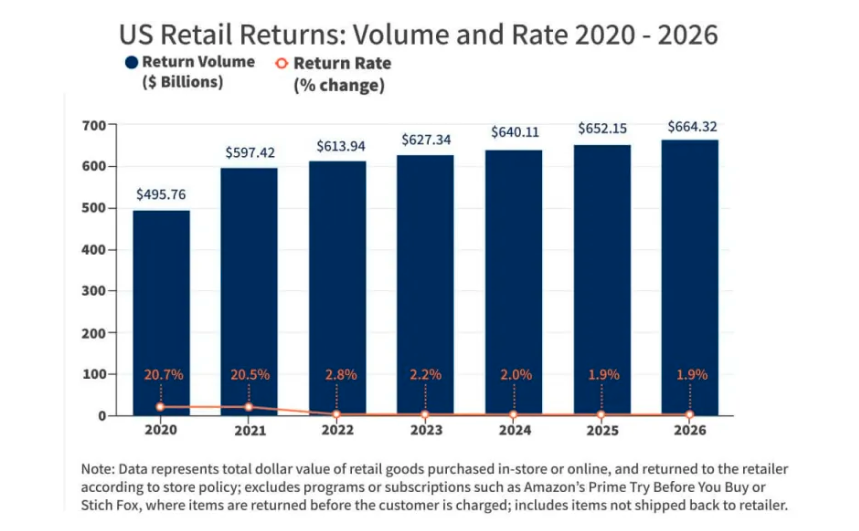Welcome to Parcelconsulting
Welcome to Parcelconsulting

The increasing prevalence of online product returns presents a complex challenge that, when navigated successfully, can transform customer dissatisfaction into loyalty. Understanding the ecommerce product returns, from the initial reasons behind the high rate of product returns in ecommerce to creating a policy that addresses these concerns efficiently, is essential. The significance of an optimized returns process cannot be understated, given its direct impact on customer satisfaction and the bottom line.
Returns have become a significant factor influencing customer satisfaction and business success. With return rates averaging between 20-30% for online purchases, it’s clear that managing returns effectively is not just a necessity but a strategic component that can shape the overall customer experience.

Online stores’ return policies play a crucial role in shaping consumer expectations regarding returns. A longer returns window, for instance, often correlates with an increase in sales as customers feel more secure in their purchasing decisions. This security comes from knowing they have ample time to decide whether to keep a product, which in turn reduces the perceived risk associated with online shopping.
The expectation for hassle-free returns is becoming a standard that online retailers must meet. To adapt, many brands are enhancing their logistics to offer more returns processing locations closer to the consumer, thereby not only meeting customer expectations but also reducing costs and improving the overall return experience.
However, while free returns are favored by consumers, they can also encourage a behavior known as “intentional returning,” where customers purchase products with the intention of returning them. This behavior highlights the delicate balance businesses must maintain between accommodating consumer preferences and mitigating potential abuses of return policies.
In conclusion, understanding and addressing the complexities of ecommerce returns is crucial for businesses aiming to enhance customer satisfaction and encourage repeat business. Aligning return policies with consumer expectations and economic realities allows businesses to enhance operational efficiency while fostering customer loyalty.

The foundation of an effective return policy is transparency. When customers have a clear understanding of a company’s return policies, covering aspects like timeframes, eligibility criteria, and associated expenses, they feel more assured and self-assured in their buying decisions. Clear communication of these conditions builds trust and reduces the uncertainty that can result in returns.
A well-crafted return policy should feature clear and concise terms. Transparently conveying the terms for returns, encompassing details such as timeframes, eligibility criteria, and any connected expenses, is imperative. This clarity helps eliminate uncertainty and build trust. Moreover, ensuring the accessibility of the return policy across multiple platforms, including the company’s website and various touchpoints throughout the purchasing journey, fosters confidence and underscores a dedication to customer contentment.
The seamlessness of the return process significantly influences customer satisfaction. A return policy that is flexible and devoid of unnecessary hurdles enhances the overall shopping experience. Knowing they can easily return a product that doesn’t meet their expectations encourages customers to make purchases with confidence.
Crafting a returns policy that prioritizes user-friendliness involves simplifying the returns process for customers. Provide them with intuitive online tools, automated return systems, and straightforward instructions to facilitate returns. Offering an extended return window enhances satisfaction and fosters repeat business by allowing customers sufficient time to assess their purchases and initiate returns if necessary.
Transparency is key to an effective return process. Ensure your return policy is easily accessible on your website and clearly outlines the conditions for returning products, including timeframes, packaging guidelines, and any associated fees. By transparently communicating these details, you establish clear expectations and prevent potential confusion or dissatisfaction.
In order to provide a frictionless return process, streamline the procedures for initiating a return and offer various return options, like drop-off locations or pre-paid shipping labels. You might even contemplate providing refunds or exchanges without necessitating customers to return the item first, particularly for lower-priced products. This approach demonstrates confidence in your products and removes barriers to purchase.
Prompt refunds or replacements are crucial. Promptly resolving return requests contributes to building trust in your brand and encourages repeat purchases from customers. Prioritize a customer-centric return process by offering clear instructions and diverse options for product returns. By actively listening to feedback from returns and implementing improvements, you demonstrate your dedication to customer satisfaction, thereby cultivating trust and a positive brand reputation. Ultimately, this fosters stronger customer loyalty and confidence in your business.
A well-crafted ecommerce return policy is more than a necessity—it’s a strategic asset that can boost customer satisfaction and increase sales. To craft a policy that aligns with both business objectives and customer needs, it’s crucial to understand the foundational elements that make a return policy both functional and customer-friendly.
Employ these tactics to guarantee customers are informed about your returns policy and can readily locate it when necessary:
Efficient handling of returns logistics plays a pivotal role in upholding customer satisfaction and managing expenses. Here’s what you need to know about managing the physical process of returns, utilizing technology to streamline operations, and minimizing costs associated with returns logistics.
Managing the physical process of returns effectively requires a streamlined, efficient approach that minimizes costs and maximizes customer satisfaction. Start by implementing a clear and straightforward return authorization system that allows customers to easily initiate returns online. Use automated systems to generate prepaid return labels and track return shipments, ensuring transparency for both the business and the customer.
Designate a specific area within your warehouse for processing returns to keep operations organized and efficient. Promptly examine returned merchandise to evaluate its state, swiftly restocking items in good condition and handling damaged or faulty products accordingly. Utilize inventory management technology to instantly update inventory levels, guaranteeing precise product availability.
What’s more, be sure to scrutinize return analytics to pinpoint patterns and rectify any repetitive product or procedural concerns. By adopting these best practices, businesses can handle returns more efficiently, reduce turnaround time, and maintain a high level of customer satisfaction.
Minimizing costs associated with returns logistics involves implementing several strategic options to streamline the process and reduce expenses. Begin by elevating product descriptions and employing top-tier visuals to mitigate returns resulting from unfulfilled expectations. Introducing the option for in-store returns of online orders can mitigate shipping expenses and enhance customer convenience.
Rely on data analytics to identify patterns in returns, enabling targeted improvements in product quality and packaging. Implement a tiered return policy that incentivizes customers to return items within shorter timeframes, reducing the window for potential damage or obsolescence.
Partner with third-party logistics providers specializing in reverse logistics to benefit from their expertise and economies of scale. Additionally, consider refurbishing and reselling returned items where possible, recapturing some of the product’s value. By adopting these measures, businesses can significantly lower the costs associated with returns while maintaining a positive customer experience.
Employing these tactics enables businesses to streamline return processes, uphold superior customer satisfaction, and mitigate the economic repercussions of returned items.

Reducing the rate of returns is a critical aspect of managing a successful ecommerce business. Elevated rates of product returns can markedly affect both profit margins and customer contentment. Implementing effective strategies to minimize returns is essential for enhancing the overall customer experience and maintaining a healthy bottom line.
One effective approach to reducing return rates is to ensure that all product descriptions are specific and detailed. This provides consumers with a precise comprehension of their purchase, aligning their expectations with the actual product. Highlighting the benefits of a product is important, but it is equally crucial not to overstate its functions, as this can lead to disappointment and returns.
High-quality Product Detail Page (PDP) images are another vital component. These images should be of high resolution and offer multiple views to fill any gaps in consumer understanding that might arise from reading product descriptions alone.
Additionally, incorporating customer reviews can provide prospective buyers with more comprehensive insights into a product. Reviews that include user-generated photos and detailed accounts of customer experiences add a layer of transparency and can greatly assist in setting the right expectations.

Training customer service teams thoroughly is crucial for reducing returns. Exceptional customer service involves not only addressing customer complaints but also proactively managing customer expectations. Teams should be well-versed in the products they represent, which allows them to provide accurate information and suggest alternatives that could better meet customer needs.
Continually investing in the training of customer service representatives equips them with the essential skills needed to provide effective assistance to customers. This includes both hard skills, like product and internal process knowledge, and soft skills, such as empathy and communication. For instance, training programs should cover product features extensively and teach representatives how to handle various customer scenarios.
Special circumstance training, such as for new product releases, ensures that customer service teams are prepared to answer queries promptly and accurately, further reducing the likelihood of returns due to misunderstandings or incorrect product expectations.
Through the adoption of these approaches, online retailers can substantially diminish their return frequencies, fostering heightened customer contentment and allegiance. This not only bolsters the financial standing of the enterprise but also fortifies its standing within a competitive commercial landscape.
Returns data isn’t just about managing the logistics of returned items; it’s a goldmine of insights that can propel a business towards greater efficiency and customer satisfaction. By meticulously analyzing the reasons behind returns, businesses can pinpoint areas needing improvement, optimize their processes, and ultimately enhance the customer experience.
Gathering insights on returns initiates with comprehending the core factors driving customers to return items. This requires establishing a structured methodology to gather data throughout each stage of the return journey. Businesses should consider integrating standardized return reasons in their systems along with an option for customers to provide open-ended feedback. This dual approach allows for quantitative analysis through predefined categories and qualitative insights through customer comments.
Following data collection, the analysis stage commences.
Transforming the analysis into actionable insights empowers businesses to tackle the underlying reasons for returns, potentially mitigating overall return rates and enhancing customer satisfaction.
The insights gleaned from returns data are invaluable in enhancing product quality and customer satisfaction. Here’s how businesses can use this information:
Furthermore, scrutinizing returns data aids in honing product offerings to more closely match customer expectations and market needs. Taking proactive steps not only enriches the customer journey but also fortifies the brand’s standing by showcasing a commitment to integrating customer feedback and continuous improvement.
Incorporating these strategies ensures that the returns process isn’t just a logistical operation but a strategic tool that enhances product quality, customer satisfaction, and operational efficiency.
To attract and retain shoppers, understanding the pivotal role of a well-managed returns process is crucial. Crafting a returns experience that balances convenience, sustainability, and appealing incentives is key to fostering long-term customer loyalty. By placing the shopper at the center of the returns and exchange policy, businesses can significantly enhance customer retention efforts both now and in the future.
Crafting a customer-centric return policy and optimizing the returns procedure are key elements in turning a potentially unfavorable encounter into a positive one, thereby strengthening customer loyalty. This demonstrates that a straightforward and accommodating return policy is not just a necessity, but a strategic asset that can lead to increased customer retention and, subsequently, higher profits.
Introducing seamless return policies and refining the return procedure can greatly influence how customers perceive a brand and their loyalty towards it. For instance, offering immediate refunds or initiating them the moment an item is returned can alleviate customer concerns about the return process. Additionally, prioritizing exchanges over refunds can help retain customer spending and loyalty, by encouraging customers to choose an alternative product rather than simply returning for a refund.
Effectively managing returns in the realm of online shopping significantly contributes to elevating customer contentment and propelling the triumph of e-commerce endeavors. This article has explored the complexities of ecommerce returns, emphasizing the importance of an optimized returns process. Key strategies include crafting transparent and customer-centric returns policies, leveraging technology to streamline returns logistics, and analyzing returns data to identify areas for improvement. Additionally, reducing return rates through accurate product descriptions and high-quality images, along with training customer service teams, is crucial. By prioritizing these aspects, businesses can turn returns from a hurdle into a chance to cultivate customer loyalty.
Parcel Consulting is the ideal partner for businesses seeking to audit and optimize their shipping and return policies. With expertise in creating streamlined, customer-friendly return processes, Parcel Consulting can help you enhance your operational efficiency and meet consumer expectations. Tailored solutions ensure that your returns policy aligns with your business objectives while maximizing customer satisfaction. By leveraging their industry knowledge and innovative approaches, you can turn returns into a strategic advantage, fostering long-term customer loyalty and improving your bottom line.
Get Started with Parcel Consulting Today! Contact us now to schedule a consultation and discover how we can help you set up a Virtual Carrier Network that revolutionizes your logistics operations. Visit our website to take the first step towards a more efficient and cost-effective shipping solution.